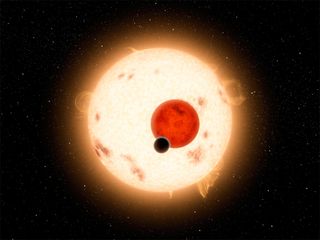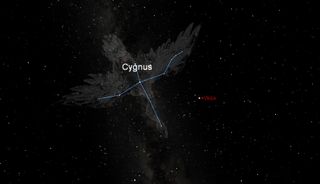
Scientists have spotted a real-life Tatooine — a world with two suns, like Luke Skywalker's home planet in the "Star Wars" films — and you should be able to see this alien star system, too, using a good pair of binoculars.
Astronomers announced the discovery of the alien planet, called Kepler-16b, today (Sept. 15). The Saturn-mass planet orbits a pair of stars known as Kepler-16A and Kepler-16B. Someone on Kepler-16b would see two suns hanging near each other in the sky, just as Luke did on Tatooine.
The Kepler-16 star system is just 200 light-years from Earth, in the constellation Cygnus (the Swan). Because it's so close, it should be visible to many amateur skywatchers, researchers said.
The sky map of Cygnus here shows the constellation as it currently appears high overhead at night.
"If you want to find Kepler-16, it's 11 1/2 -magnitude," Laurance Doyle of the Search for Extraterrestrial Intelligence (SETI) Institute, lead author of the paper announcing the discovery of Kepler-16b, told reporters today. "You could probably squint and see it through binoculars." (On an astronomer's scale, lower magnitudes represent brighter objects.)

Cygnus has three stars in its right wing, Doyle said. The key is to find the bright star in the middle, called Iota 2 Cygni, which shines with a magnitude of about 3.
"If you can find that, you're within 1 1/2 degrees of Kepler-16b," Doyle said. The width of your clenched fist held at arm's length covers about 10 degrees. [The Strangest Alien Planets]
Get the Space.com Newsletter
Breaking space news, the latest updates on rocket launches, skywatching events and more!
Seeing the point of light representing the Kepler-16 system would be neat enough. But next year, amateur astronomers may actually get to spot the newfound alien planet Kepler-16b — or, at least, see some evidence of the existence of this circumbinary planet.
NASA's Kepler space telescope detected the exoplanet by noticing the telltale dips in brightness caused when Kepler-16b passed in front of its parent stars. It will make another transit on June 28, 2012, dimming the star Kepler-16A by about 1.7 percent, according to Doyle.
The transit will occur during daylight hours in the United States and Europe — but much of Asia will be invitingly dark.
"That will be visible from China, India, Russia, Korea and Japan and so on," Doyle said. "So if you're an amateur and you want to detect the first transit since the discovery of a circumbinary planet, you can go to the northeastern hemisphere of Earth."
A 1.7 percent drop in a star's brightness is something amateurs with a decent telescope and CCD (charge-coupled device) imager can pick up, Doyle said. Off-the-shelf versions of this equipment would be fine, he added.
You can follow SPACE.com senior writer Mike Wall on Twitter: @michaeldwall. Follow SPACE.com for the latest in space science and exploration news on Twitter @Spacedotcom and on Facebook.
Join our Space Forums to keep talking space on the latest missions, night sky and more! And if you have a news tip, correction or comment, let us know at: community@space.com.

Michael Wall is a Senior Space Writer with Space.com and joined the team in 2010. He primarily covers exoplanets, spaceflight and military space, but has been known to dabble in the space art beat. His book about the search for alien life, "Out There," was published on Nov. 13, 2018. Before becoming a science writer, Michael worked as a herpetologist and wildlife biologist. He has a Ph.D. in evolutionary biology from the University of Sydney, Australia, a bachelor's degree from the University of Arizona, and a graduate certificate in science writing from the University of California, Santa Cruz. To find out what his latest project is, you can follow Michael on Twitter.
